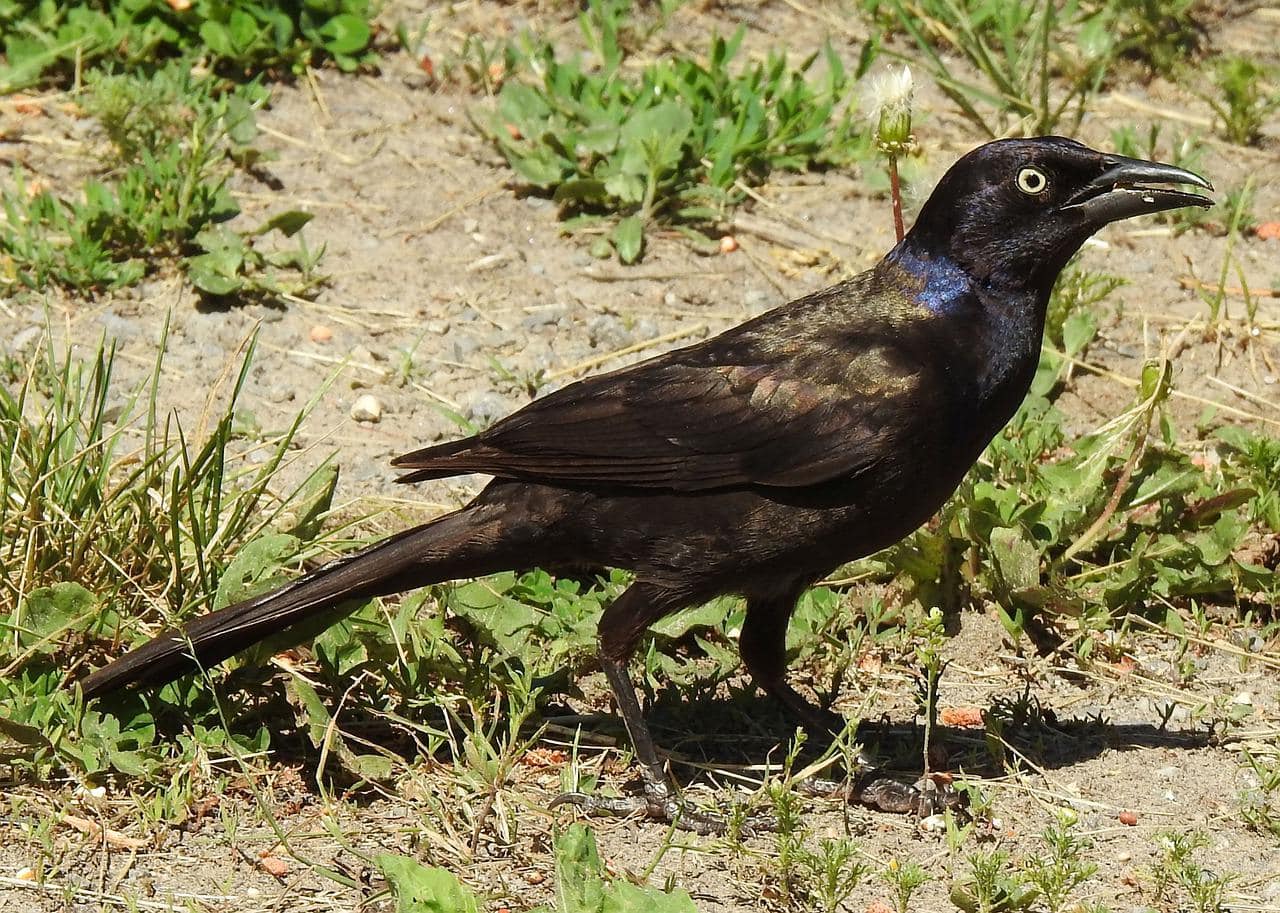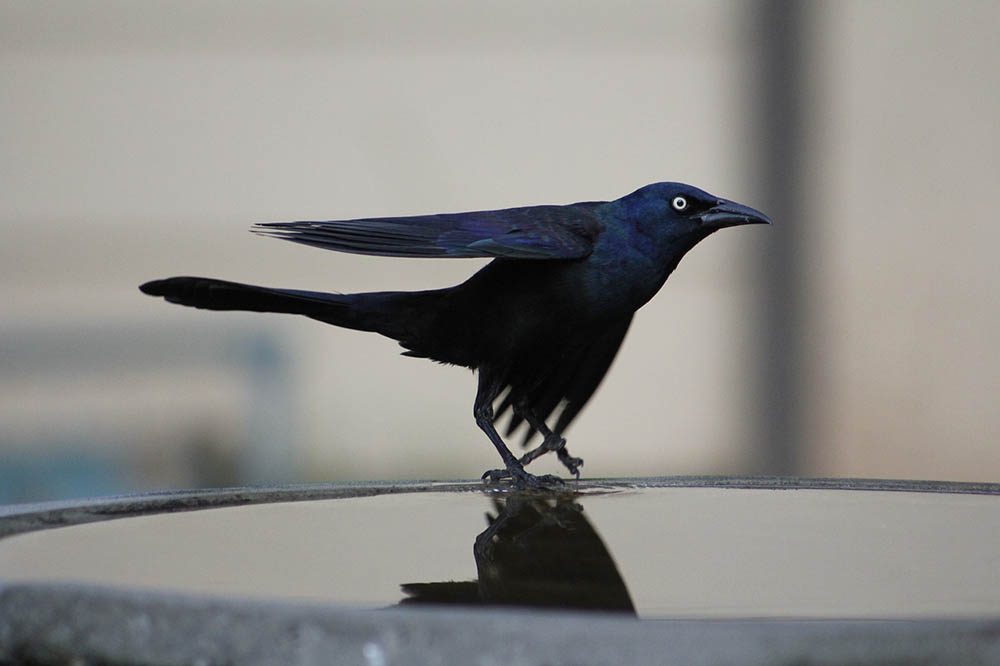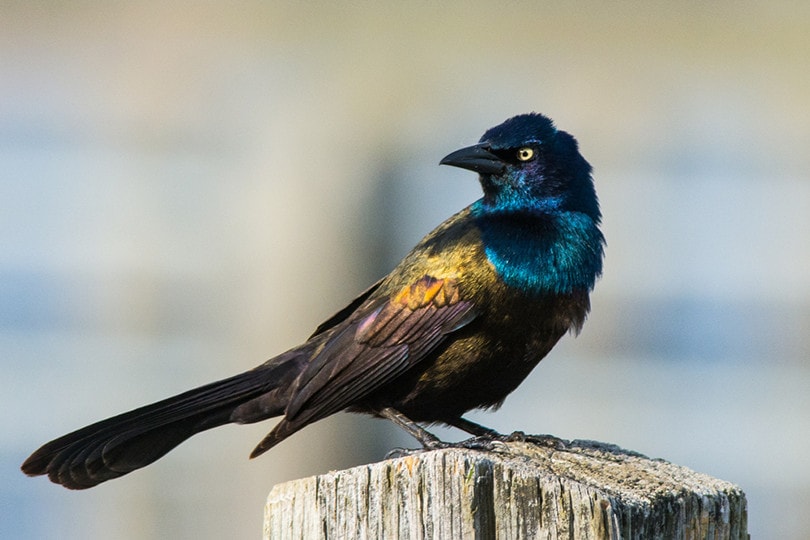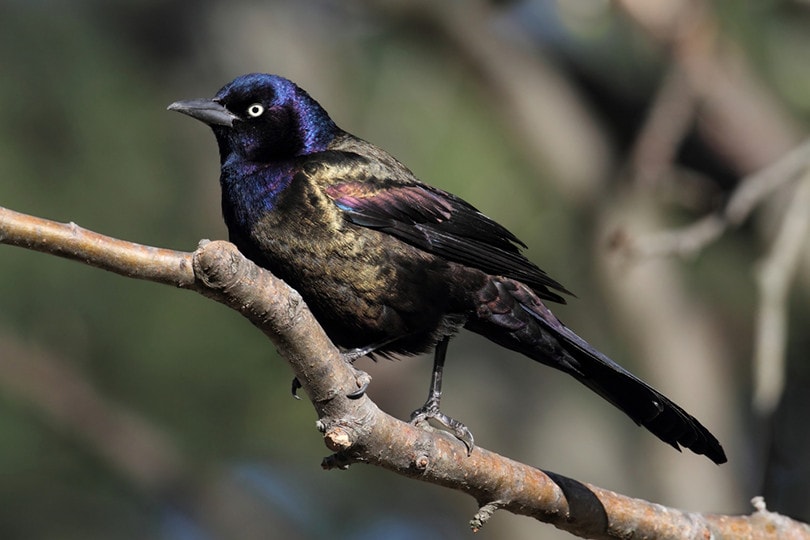Common Grackle: Field Guide, Pictures, Habitat & Info
Last Updated on

A Common Grackle is a tall blackbird with a longer tail than most blackbirds. These birds have distinctive tapered bills, glossy bodies, and yellow eyes. These purplish-black birds are seen all over the United States, so it’s not that hard for you to find them.
Grackles like to walk in fields and lawns with their long legs. They are often found in flocks on trees or open woodlands. You can easily identify them by their loud squeak. In fact, these birds come together in noisy groups in evergreens.
A Grackle can eat anything. Since these birds are ground foragers, they feed on different types of crops, especially corn and even garbage.
If you’re a passionate birdwatcher, focus on the long tail trail (sometimes folded down from the middle in V-shape) behind Common Grackles when flying. Let’s explore more about these birds.
Quick Facts about Common Grackle
| Habitat | Open woodlands |
| Diet | Omnivore; seeds, insects, and other birds |
| Behavior | Ground forager |
| Nesting | Tree |
| Conservation | Common Bird in Steep Decline |
| Scientific name | Quiscalus quiscula |
| Lifespan | 17–22 years |
Common Grackle: General Description
Common Grackles have glossy, iridescent, and elongated bodies characterized by their long legs and tails. Adult Grackles have a dark bronze-purple upper body with a shiny blue-green head. These birds also have bright yellow eyes, long and slightly curved bills, and stretched and upward curled tails.
Males usually fly with their tails curled in a shallow “V” shape. Females are pretty similar to the males but are dull-colored with short and straight tails. Grackles have a harsh gurgling squeak that sounds like, “kree del eeeek,” while the call sounds like a, “chlack.”
These birds visit agricultural fields, city parks, suburban lawns, and feedlots. They also fly around open habitats, such as woodland, meadows, forest edges, and marshes.
The oldest Common Grackle was a male who lived for 23 years and one month but was killed in 1994 by a raptor.

Common Grackle: Range, Habitat, Behavior, Diet & Nesting
The striking purple and black color combination of this bird is indeed enough to steal your attention, but what more should you know? Here is the basic information about Grackles:
Range
Common Grackles are short-distance migrant or resident birds. Grackles from Canada, the far-northern US, and the Great Plains fly to the southern and central US.
Habitat
Common Grackles go well with human landscapes and prefer open grounds for foraging. They build their nests in scattered trees. Their typical natural habitats are open woodland, meadows, forest edges, marshes, grassland, palmetto, and hammocks.
These birds are also found around city parks, agricultural fields, cemeteries, suburbs, hedgerows, and pine plantations. You are probably looking in the wrong place if you search for Grackles in unbroken forest tracts. These birds don’t like such sites.
Behavior
Common Grackles flock with other blackbirds, starlings, and cowbirds, particularly in winter. Because of their taller bodies, they easily tower over others and push them away from the food at feeders. Grackles forage on the ground and fly high to the trees or power lines.
You may see these birds nesting in colonies of around 200 pairs. These loose colonies show little territoriality, excluding the area close to the nests.
Grackles usually mate or pair in spring. When pairing, they show three kinds of behavior. First, a flock of males flies after a female. Then, a single male chases after a female. And third, a male and female start flying slowly alongside each other.

Diet
Common Grackles like to eat seeds, especially agricultural grains like rice and corn. They also forage on sunflower seeds, acorns, garbage, and tree seeds like wild fruits, sweetgum, and cultivated fruits.
In the summer season, they include animals, such as grasshoppers, spiders, beetles, caterpillars, mollusks, frogs, salamanders, mice, crustaceans, and other birds.
Nesting
The female Grackle visits different sites and chooses the nesting site, sometimes accompanied by the male. The female often changes their mind about the nesting site after the nest-building starts.
Females are usually in charge of nest building, while males may help them. It takes around a week to six weeks to complete the process. The resulting nest is a bulky cup made of grasses, twigs, and leaves with cloth, paper, or string.
The nest is typically built on a coniferous tree branch between two vertical or horizontal branches. Horizontal nests have been recorded around 8 inches above the ground in cattails and deciduous vegetation.
Common Grackles prefer building their nests near water sources. However, you may also find their nests in barns, woodpecker holes, birdhouses, and cliff crevices.
How to Find Common Grackles: Birdwatching Tips

Common Grackles are easy to find in almost every part of the United States and Canada. Here are some tips to help you find these birds without much hassle:
What to Listen For
Common Grackles have a harsh, gurgling, and loud squeak, “kree del eeeek,” and a call like “chlack.”
What to Look For
Some distinctive characteristics of Common Grackles include:
- Size and Shape. These are stretched blackbirds with long tails and legs. They have flat heads and longer bills than most blackbirds, slightly curved downward. Grackles are bigger than a Red-winged Blackbird and the same size as a Mourning Dove. Both genders measure 0–13.4 inches (28–34 cm) in length and weigh 2.6–5.0 ounces (74–142 g). Their wingspan is 14.2–18.1 in (36–46 cm).
- These birds appear black with glossy purple heads that stand out on their bronzy-iridescent bodies. Females are relatively less glossy than males. They have bright golden eyes. Young Grackles are dark brown.
- Grackles are ground foragers. You will likely find them flying around open woodlands and agricultural fields.
When to Look
Look around open woods and marshes in winter. Common Grackles gather in large communal flocks of different blackbird species. One flock can even consist of millions of birds.
These birds are both winter and summer residents in most parts of the US. When spring starts, these birds start their loud creaky calling, courtship displays, and purposeful strutting. You’re likely to see most of their nestings in trees in late March and April.
Attracting Common Grackle to Your Backyard: Tips & Tricks

The Common Grackles’ most preferred habitats are trees and agricultural fields. They can also visit your backyard as they’re ground foragers. However, you need to attract them the right way. Here are a few tips to keep in mind:
- Install Bird Feeders. Common Grackles love to eat seeds and insects from various feeders, whether tray, window, or hopper feeders. So, buy some high-end feeders and fill them with top-quality foods that Grackles love.
- Place the Feeder Properly. Feeder placement plays a significant role in attracting these birds to your yard. You need to put the feeder where other animals, like cats or squirrels, can’t reach. So, place these feeders a few inches above the ground and away from the trees to ensure that only Grackles get them. These birds are ground foragers, so it won’t be difficult for them.
- Lure Grackles With Their Favorite Foods. Grackles love to eat sunflower seeds, acorns, and corn fields. Search for these foods and use them to attract these birds to your backyard. Remember to always use safe and reputed brands for bird baits.
- Clean the Feeders. Common Grackles prefer fresh water. Therefore, keep the feeders clean to encourage these birds to fly away from their natural habitat and come to your yard.
- Use a Heated Birdbath in Winter. Birds look for water on both warm and cold days. Thus, placing bird baths in your backyard is an effective way to lure these birds. One thing to remember is that the water in your birdbath usually freezes on colder days. So, use a heated bird bath in the winter to attract these birds throughout the year.
Common Grackle Conservation: Is This Bird Threatened?
Common Grackles are widespread birds found all over the US and Canada. However, according to the North American Breeding Bird Survey, their population has declined by around 2% per year from 1966 to 2019. This accumulated to a decline of about 54% over that period.
Partners in Flight evaluates Grackles’ global breeding population to be around 67 million, listing this bird in the category of “Common Bird in Steep Decline.” In addition, Common Grackles have a 9 out of 20 rating on the Continental Concern Score.

Final Thoughts
Common Grackles are abundant blackbirds in the US and Canada, characterized by their elongated bronzy-purple bodies and glossy heads. Their bright yellow eyes and long tails make these birds strikingly beautiful. On your next trip to open woodlands, don’t forget to observe the loud, squeaky noise of Grackles.
Featured Image Credit: Bernell, Pixabay
Table of Contents
About the Author Jeff Weishaupt
Jeff is a tech professional by day, writer, and amateur photographer by night. He's had the privilege of leading software teams for startups to the Fortune 100 over the past two decades. He currently works in the data privacy space. Jeff's amateur photography interests started in 2008 when he got his first DSLR camera, the Canon Rebel. Since then, he's taken tens of thousands of photos. His favorite handheld camera these days is his Google Pixel 6 XL. He loves taking photos of nature and his kids. In 2016, he bought his first drone, the Mavic Pro. Taking photos from the air is an amazing perspective, and he loves to take his drone while traveling.
Related Articles:
10 Types of Hummingbirds in Arkansas (With Pictures)
8 Types of Hummingbirds in Nebraska (With Pictures)
5 Types of Hummingbirds in Idaho (With Pictures)
3 Types of Hummingbirds in Mississippi (With Pictures)
8 Types of Hummingbirds in Kansas (With Pictures)
5 Types of Hummingbirds in West Virginia (With Pictures)
5 Types of Hummingbirds in Ohio (With Pictures)
Where Do Nuthatches Nest? Nuthatch Nesting Habits Explained
